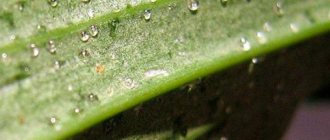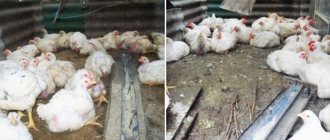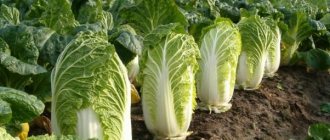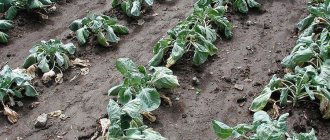Sometimes cabbage develops purple leaves, and this is an alarming sign that the development of the vegetable is abnormal. The reasons for their appearance lie in care errors, damage to the crop by diseases and pests, and a lack of nutrients in the soil. The problem can be fixed quickly, so it will not affect the yield in any way. Reviews from experienced gardeners will tell you what to do first and how to feed the plants.
Reasons for the appearance of a purple tint
There are several reasons why cabbage turns purple. There are cases when this does not pose a danger to the crop. But a number of them are cause for concern and require intervention.
Stress
The reason for the purple tint of cabbage leaves after planting in the ground may be the seedlings getting used to lower temperatures. A sharp cold snap can also cause cabbage leaves to change color. It does not pose a threat to the crop. Everything returns to normal after the air temperature changes or the seedlings get used to the cold.
Lack of moisture or excess will also cause cabbage leaves to change color. In the first case, additional watering of the plants is needed. In the second, stop watering, loosen the soil more often, and in rainy weather drain the water using a ditch.
Phosphorus deficiency
Lack of phosphorus in the soil is another reason for the appearance of purple veins on the underside of leaves. In this case, you need to add the necessary fertilizers. It is necessary to use quickly digestible fertilizers, for example:
- Potassium monophosphate, which contains 50% phosphorus and 33% potassium. (About him in the article: How to use Potassium Monophosphate)
- Superphosphate, 100 g of substance per bucket of water. Use 0.5 liters per bush.
- Double superphosphate, 50 g per 10 liters of water, use 35-50 g per 1 sq. meter. (How to use Double Superphosphate)
- Bone meal, 1 teaspoon per 1 liter of water, allow the drug to completely dissolve.
- Humus or chicken manure, 3-5 kg per 1 sq. meter. (Humus as fertilizer)
Pest infestation
When a crop is infected with a fungus, the cabbage leaves may change color.
The fungal disease blackleg, which causes discoloration of cabbage leaves, has no cure. The bush is removed and the ground is treated in the fall with special fungicides.
Cabbage fly larvae can damage the roots of the plant. In the 2nd case, use insecticidal preparations: Topaz, Iskra and others according to the instructions.
Features of the variety
When planting crops, gardeners must take into account climatic conditions, soil characteristics and plant variety. According to the ripening period, cabbage can be early, medium and late ripe. There are varieties that are more and less resistant to changes in temperature and humidity, which can cause plant disease. You need to choose a variety that is resistant to the above reasons.
Features of planting and growing
Having discussed all the possible causes of blue cabbage leaves, it is also necessary to recall the importance of choosing disease-resistant varieties, planting on suitable soil and proper care.
Important! Transplantation and any movement is perceived by plants as stress. For this reason, after planting in a permanent place, you need to provide good lighting, do not over-moisten the soil and do not fertilize for about 10 days.
Choosing the right variety
When choosing cabbage for planting, you need to consider the following points:
- plant varieties suitable for your climate zone;
- It is better to grow varieties of different ripening periods;
- late varieties such as Kilaton or Ramkila have good resistance to clubroot, mid-season varieties - Kilagerb and Tequila, as well as early varieties - Kilagreg and Kazachok;
- Many gardeners love the late hybrid Aggressor, suitable for all climatic regions. It is resistant to late blight, fusarium, as well as attacks by aphids and fleas. The Belosnezhka, Amager and Moskovskaya varieties have similar qualities;
- popular among vegetable growers in Ukraine and the South of the Russian Federation are such early varieties as Vspishka, Rassvet, Legat or Aigul, as well as mid- and late-ripening Brigadir, Potomac, Kharkovskaya Zimnyaya and Centurion;
- for the middle zone, early varieties Kazachok or June, mid-ripening varieties Kilagerb, Rinda or Slava 1305 and late-ripening Ramkila, Kamennaya Golova, Megaton or Kronos are suitable;
- In Siberia and the Urals, cold-resistant early varieties Kazachok, Iyunskaya, Nadezhda or Tequila are grown.
Vegetable growers usually do not stop at one variety; they constantly try new ones and select crops wisely, which ensures a continuous conveyor of vegetable products.
Choosing a landing site
When deciding on a planting site, you need to know about the requirements of this crop:
- the vegetable is demanding on lighting, so you need to choose sunny areas;
- Loose loam or sandy soils are considered optimal soils for cabbage;
- the soil must be fertile, therefore, when digging in autumn, it is advisable to add 5–6 kg of humus, superphosphate (2 tbsp.) and potassium chloride (1 tbsp.) per square meter;
- the culture loves moisture, but does not tolerate stagnant water, so low-lying areas are not suitable;
- you cannot plant after such predecessors as radishes, radishes and other cruciferous vegetables (they have common diseases and pests);
- Suitable precursors are cereals, legumes or carrots.
Care
To obtain a high-quality and abundant harvest, you need to comply with certain requirements in caring for the crop:
- observe crop rotation (return to their original place no earlier than after 4 years) and do not plant after cruciferous vegetables;
- disinfect the soil (copper sulfate or other suitable means) and liming acidic soils (lime, dolomite flour);
- carry out pre-sowing treatment of seeds and hardening of seedlings;
- apply the necessary fertilizing in a timely manner;
- carry out preventive measures to prevent diseases and pest invasions;
- control soil moisture and carry out regular watering to keep the soil moderately moist.
Did you know? A very poisonous plant grows in the swamps of North America
-
skunk cabbage.
Its “aroma” is similar to the smell emitted by a skunk in extreme situations. This plant is also unusual in that it is capable of thermoregulation (maintaining temperature, like in animals) thanks to the heat produced by the mitochondria. Armed with the necessary knowledge, even a novice gardener can grow healthy plants and get a good harvest. We hope that our recommendations will help you with this. Good luck and success in gardening!
How to save the harvest
To do this, you need to eliminate the reasons that cause the change in color of the leaves of the crop.
How to feed cabbage whose leaves have turned blue
First of all, use fertilizers with a high phosphorus content. If this happens in the middle of summer, use one and a half doses of the drugs mentioned above. At the beginning of summer, when growing green mass, it is possible to use the following means:
- mullein infusion in a ratio of 1:10;
- urea or ammonium nitrate according to the instructions;
- infusion of bird droppings in a ratio of 1:10.
Optimal temperature for growing cabbage
The most favorable temperature for growing cabbage will be from +15 to + 18 degrees. When the thermometer rises above +25 degrees, the culture accumulates nitrates and develops worse.
Getting rid of pests on cabbage
The cabbage fly lays eggs at the end of May. After 10 days, the larvae of this insect appear. They eat up the roots of plants, which leads to blueness of the lower leaves of the crop. Gradually the cabbage dies.
Traditional methods help in pest control.
- It will be effective to use ash in dry form or in solution. Stir 1 glass of the substance in 10 liters of water, leave for 24 hours and use 0.5 liters per bush.
- Spraying plants with 6% vinegar will also have a positive effect.
- An infusion of onion peels is often used to repel pests. Take 200 g of chopped onion and onion peel, pour 2 liters of boiling water, and leave for at least 1 hour. Then it is brought up to 10 liters and about 5 liters are used per bush or the plant needs to be sprayed.
- You can use an infusion of celandine; to do this, take 1 cup of crushed plants, pour 2 liters of boiling water and leave for at least 1 hour. Add liquid to 10 liters and apply 500 ml. under a bush
- Among chemical preparations, the use of Karbofos or Chlorophos will be effective. You need to dissolve 20-30 g of the drug in 10 liters of water and use 1 glass of solution for each bush. It is safest for humans to use Deltamethrin according to the instructions.
Eliminating the effects of stress
Cabbage, like any plant, is subject to stress when conditions change. First, you should analyze the changes that appeared while caring for the plant: maybe the appearance of a purple color or blue color on the foliage is caused by a sharp cold snap or frequent watering of the plant? You can protect cabbage from cold: snow, hail by covering it with spunbond insulating material. If there is no covering material, then the soil should be mulched with peat or sawdust.
See also
20 best varieties of Chinese cabbage with descriptions and characteristics
Read
Overmoistening the soil can also cause cabbage leaves to turn blue. Prolonged rainfall during the summer growing season can contribute to stress. On such days there is no need to water; soil loosening should be increased. You can make narrow furrows to drain excess water.
Preventive methods
In order not to wonder why cabbage has purple leaves, we need to prevent this problem. It is important to disinfect the seeds with a weak solution of manganese. When planting in the ground, treat the seedlings with Kornevin and spill the soil with a weak solution of manganese.
What soil should I plant cabbage in?
The soil for cabbage should be slightly acidic or neutral. Clubroot develops in acidic soil. Previously, we told you what clubroot on cabbage is and how to deal with it.
Kila on cabbage
The crop loves fertile soil; when digging the soil and planting plants in beds, add organic fertilizers. It is useful to add wood ash to the soil at the rate of 1-1.5 cups per 1 square meter. meter. This will disinfect the soil and feed the plants.
Cabbage care
Cabbage is a moisture-loving plant. Water at least once every 3-4 days in spring and every 2-3 days in summer. Liquid consumption is approximately 8 liters per 1 sq. meter. It is advisable to use cold water, this prevents parasites from developing. Watering should be carried out in the morning or evening.
Be sure to loosen the plants to develop the root system. Do this once a week to a depth of no more than 5 cm so as not to damage the roots of the plant. In rainy weather, it is advisable to loosen after rain to destroy the crust and provide access to oxygen.
Feed the plants at least 4-5 times per season.
- The first feeding is 2-3 weeks after planting in the ground. Mullein infusion is used. Water the roots with 0.5 liters of solution.
- Carry out the procedure a second time 2 weeks after the first. Use mullein infusion at the rate of 0.5 kg of manure per 10 liters of water and leave for 3-4 days. Apply 0.5 liters per bush.
- In mid-June, the plants are fed with a mixture of superphosphate and potassium sulfate. Dissolve 1 tablespoon of the product in 10 liters of water and use at least 5 liters per 1 square meter. meter.
- In the first half of August, feed the cabbage with a nitrophoska solution, use 1 tablespoon of the drug per bucket of water. Water at the root, 0.5 liters per bush. Find out how to properly dilute nitrophoska and how to apply fertilizer.
Cabbage needs hilling. Do this 3 times per season: early summer, mid-July and early August.
Don't forget to form a bush. There is no need to immediately tear off the lower leaves; they feed the head of cabbage and help it form. They need to be removed as they dry.
Why do cabbage leaves wither?
A problem that a gardener may encounter is the wilting of cabbage leaves. The most common cause is a fungal disease such as clubroot. Upon careful examination of the root system, swellings and growths of a whitish-yellowish color are noticeable. Gradually the growths rot and the root system is destroyed. First, the leaves fade, and the head of cabbage gradually turns yellow and becomes loose.
The spores fall into the soil, where they persist for 4-6 years, so the crop can be returned to its original site after this period. The site's sanitation (predecessors) will be tomatoes and spring garlic, which will clear the soil of clubroot in 2 years.
Viral diseases of cabbage: photos and their treatment
Viral diseases are much less common, but they spread very quickly, they are almost impossible to cure, and they are the cause of complete loss of crops. The mosaic virus (lat. Mosaic) is one of the most well-known to gardeners; it has hundreds of varieties, many of which are still unknown. It is dangerous not only for one crop, or the cruciferous family; with dirty tools and parasitic insects, it gets into the stem tissue and sap of other plants, mutates and spreads further.
Cauliflower mosaic
Viral diseases of cauliflower are much less common than fungal diseases, and the fight against them raises many questions. Mosaic caulivirus is the causative agent of the cauliflower mosaic virus. Despite the name, it is the most dangerous disease of all cruciferous crops, including all types of cabbage.
Its manifestation can be detected only a month after planting the seedlings: dark green edges appear on the leaves along the veins; Necrotic spots gradually form between the veins.
Turnip mosaic (lat. Turnip mosaic)
The causative agent is Turnip mosaic virus. The virus has a popular name - black ring spot of cabbage. Leaves with a strain of viral infection are covered with light green spots.
They are best visible on the underside of the cabbage leaf. The spots darken, grow and merge, forming necrotic spots that lead to defoliation - untimely falling of leaves.
Ways to protect cabbage from viral infections
Mosaic is viral in nature and cannot be treated with insecticides
That is why it is necessary to pay special attention to prevention:
- disinfect seeds before planting;
- remove affected plants along with the soil in a timely manner;
- remove weeds that may carry the virus;
- fight parasites.
Mosaic is most often transmitted by mechanical damage and sucking insects (aphids, mites), so it is necessary to effectively combat pests that carry the virus.
Ginura vine-bearing
There are several varieties of ginura. However, the most popular and unpretentious ginura is the climbing ginura.
Belongs to the Astrov family. The homeland of growth is exotic countries: Asia, East Africa.
The culture is ampelous and has long creeping stems, approximately 50 cm long.
Velvety leaves are oblong, wavy at the edges and pointed towards the top. They have an unusual two-tone color. At the base the leaf is purple, and in the middle of the leaf there is a sharp transition to emerald color.
The leaves and stems of the plant are covered with fleecy fringe.
Produces yellow, dandelion-like flowers.
Care requirements:
- Good lighting, no direct sunlight;
- Light, well-drained soil;
- Regular watering, in hot weather every 2-3 days;
- Annual transplants;
- Frequent pinching
- Temperature in summer up to +22°C, in winter up to +15°C.
Why do bumps appear from injections on the buttocks?
Several factors can lead to the formation of swelling after injections.
- Injection technique.
Have you heard that after injections, nurses with a “light” hand do not get “bumps”? There is a deal of truth in it. “Incorrect intramuscular injection site, administering the drug too quickly, or getting the needle into a nerve or vessel can cause injection bumps,” says the specialist. “Also, compactions can appear as a reaction to the simultaneous administration of a large volume of the drug, frequent injections into the same place,” adds Bulat Yunusov, surgeon at GMS Clinic. - Allergic reaction.
“It can develop due to an overreaction of the immune response to the drug,” the doctor adds. Or - a mixture of drugs. - “Many patients, when injecting themselves, commit the sin of mixing several different drugs in one syringe, which is strictly prohibited. This can cause irreversible complications and serious allergic reactions,” says the doctor.
- Consistency of the drug.
“Oil solutions most often cause swelling and swelling,” says Bulat Yunusov. — These are the drugs that can only be administered intramuscularly. Such injections are characterized by a longer resorption time, and, consequently, an increased risk of complications.” - Incorrectly selected needle.
“A needle that is too long or too short leads to the fact that the medicine enters either very deep muscle layers or into the subcutaneous fatty tissue, that is, it does not reach the muscle layer,” the doctor notes. - Excessive muscle tension during injection.
Intramuscular injections must be performed with a relaxed muscle and preferably in a prone position. - Patient's body weight.
“Build and weight are also factors that need to be taken into account when administering injections,” adds Bulat Yunusov. — Obese patients have a lot of subcutaneous fat. If a drug gets into it, it will inevitably lead to the formation of inflammatory changes (infiltrates, abscesses).”
To prevent injection bumps from appearing, experts advise doing injections following certain rules
“It is important to use needles of the appropriate length and diameter; the choice depends on the patient’s age, injection site, volume of fluid, amount of muscle and fat tissue and solution viscosity,” says Bulat Yunusov. — It is necessary to strictly observe the rules of asepsis and antiseptics
It is preferable to perform injections while lying on a couch or bed.”
Use in cosmetology
Red cabbage juice is a great beauty product. You can’t make a face mask out of it, especially if you still have to leave the house that day. But even drinking juice as a drink can have a positive effect on the condition of the skin of the face and body. A drink rich in nutrients will help improve skin color, make it soft and tender. But in addition to the skin, teeth and nails will also benefit from the juice. And dark-haired people can rinse their hair with cabbage juice, slightly diluted with water. From such procedures the hair will be soft and shiny.
Prevention
Variety selection
First you need to choose the right cabbage variety. The climatic and weather conditions inherent in the specific region where the vegetable crop will be grown are taken into account. Usually, varieties that are resistant to waterlogging and frost are chosen.
Soil selection
The next stage is soil selection. This vegetable crop does not grow well in acidic soils. Loamy, sandy and clayey soil types are suitable. If it is not possible to replace the acidic soil, it must be limed before planting vegetables.
Possible contraindications
Best materials of the month
- Coronaviruses: SARS-CoV-2 (COVID-19)
- Antibiotics for the prevention and treatment of COVID-19: how effective are they?
- The most common "office" diseases
- Does vodka kill coronavirus?
- How to stay alive on our roads?
Some people may experience flatulence and indigestion when consuming cabbage. But if dysfunction in the stomach is caused by white cabbage, this does not mean that the same result will be from red cabbage or broccoli. By the way, Indian Ayurveda, to facilitate the digestion of cabbage, recommends cooking it with garlic, onion or ginger in olive oil, rich in vitamin E and fatty acids. But the combination of several varieties of cabbage in one dish can increase the unpleasant effect in the form of indigestion or flatulence. Also, raw cabbage is contraindicated for duodenal ulcers.
It is also important to know that red cabbage is on the list of goitrogenic foods, the consumption of which inhibits the body’s absorption of iodine. And this is fraught with the development of iodine deficiency.
Like other cruciferous vegetables, red cabbage has the ability to absorb purines from the soil, which, when entering the human body, are converted into uric acid. Excessive consumption of vegetables can be dangerous for people with kidney disease, since their bodies are not able to fully remove excess uric acid. And this is a direct path to the development of gout.
Advice from experienced agronomists
Effective measures will help prevent problems when growing tomatoes:
- Soil made from humus, peat, garden soil and river sand helps. This is a balanced mixture.
- Moisture-loving tomato varieties are negatively affected by foliar watering. Roots require moisture.
- The quality of illumination depends on the density of plantings. There should be a distance of 1.5–2 cm between the seedlings. Then they are picked, transplanted into separate pots.
- Light should be maintained for 12 hours.
- Timely fertilizers will help prevent starvation.
If the leaves and stems of tomatoes turn purple, the reasons usually lie in violation of the growing rules. Nutritional deficiency, improper lighting, unsuitable soil and low temperatures are the main factors that change the color of green mass.
When a problem arises, it is important to take effective measures in a timely manner. It’s even better to prevent this from happening through prevention.











